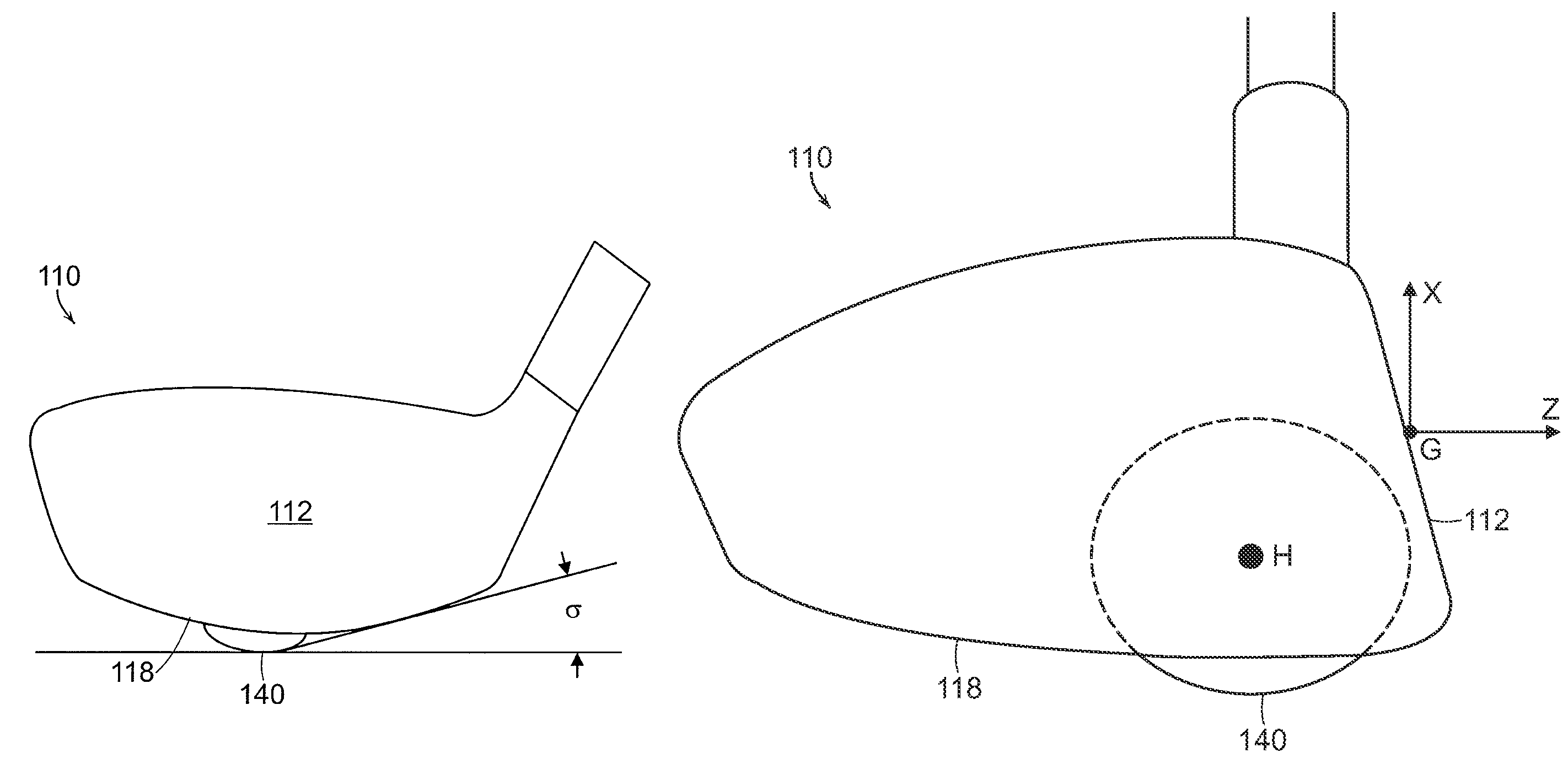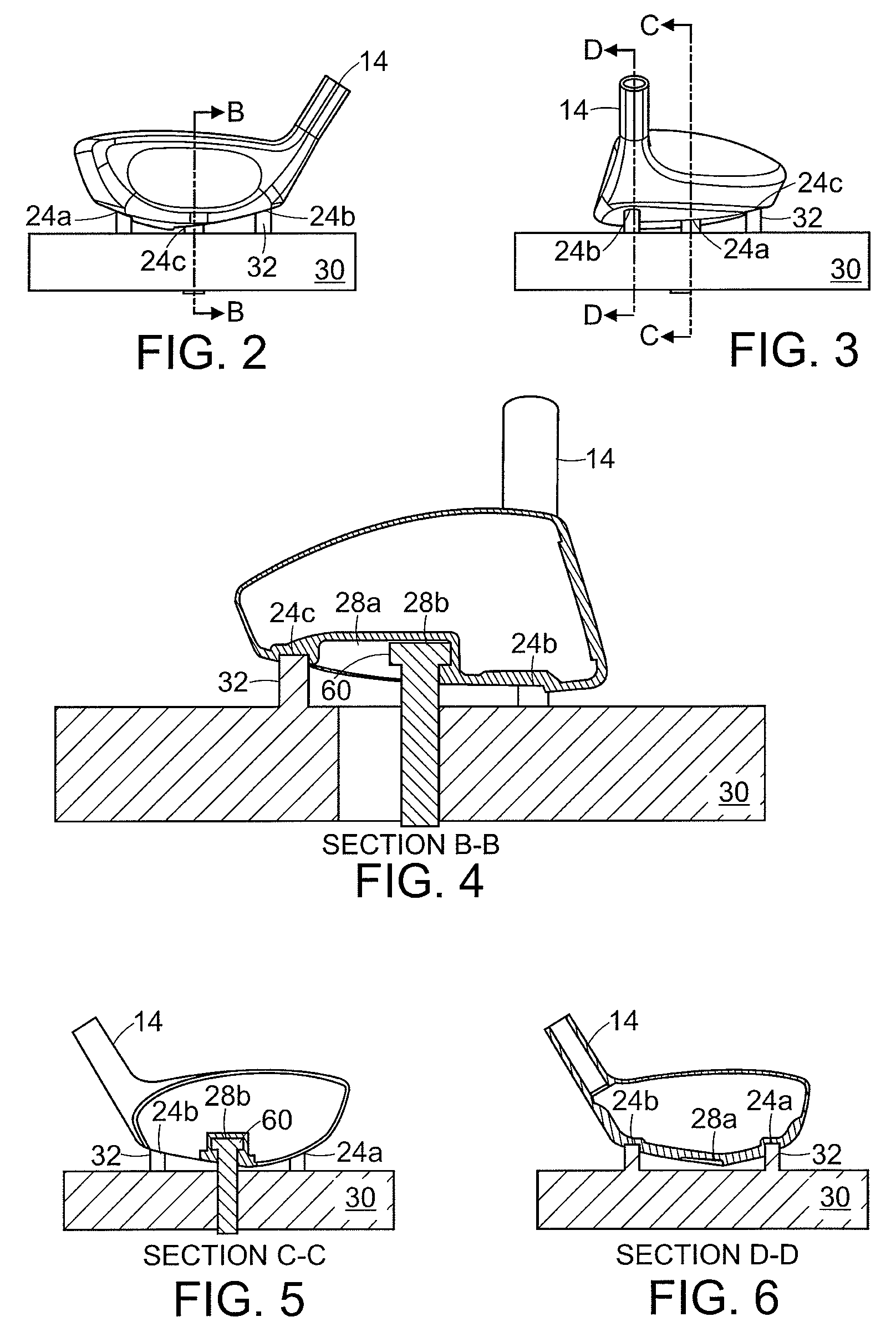Metal wood club
a golf club and metal wood technology, applied in the field of golf clubs, can solve the problems of undetectable, undetectable, undetectable hooking or slicing, and the influence of known methods on the effect of face angle, and achieve the effect of reducing the change of face angl
- Summary
- Abstract
- Description
- Claims
- Application Information
AI Technical Summary
Benefits of technology
Problems solved by technology
Method used
Image
Examples
first embodiment
[0044]In the present invention, as illustrated in FIG. 1, golf club head 10 has hitting face 12, hosel 14, back 16, sole 18 and skirt 20. Sole 18 includes three attachment points 24a, 24b and 24c. As shown in FIGS. 2-6, attachment points 24a, 24b and 24c correspond to three posts 32 on tool 30. An example of tool 30 is shown in more detail in FIGS. 7 and 8 and is preferably a machine for bending the hosels of golf club heads and thereby modifying the lie and loft angles of golf club heads. According to this embodiment, a first attachment point 24a is located on sole 18 adjacent to hitting face 12 and toward toe 20, a second attachment point 24b is located on sole 18 adjacent to hitting face 12 and toward heel 22, and a third attachment point 24c is located toward back 16 of sole 18, roughly aligned with the center of hitting face 12. This configuration of three attachment points optimizes the stability of club head 10 as it rests on posts 32, as three is the minimum number of points...
second embodiment
[0053]According to another aspect of the present invention and shown in FIG. 12, contact area 40 is located on sole 18 on or parallel to the X-Y plane that includes the point M at the top of grip 65 and the center of gravity of club 50, called point N. Contact area 40 may be on the line that includes M and N or may be toe-ward of the intersection of said line with sole 18. Preferably, contact area 40 is located closer to the toe of club head 10, and contact area 40 can be a contact area. This position helps to stabilize club 50 when it is supported by the hands of the golfer and is at rest in address position, as the center of gravity then behaves in a way similar to a ballast a of ship—it prevents the club from tipping or wobbling in the hands of the golfer.
[0054]In an alternative embodiment of this aspect of the current invention, shown in FIGS. 13-17, sole 118 of club head 110 includes contact area 140, comprising a sphere segment. Preferably, sphere segment 140 is located closer...
fourth embodiment
[0057]the present invention is depicted in FIG. 18 and presents sole 218 of golf club head 210, wherein pads 46a, 46b, 46c and 46d and pad 48 are incorporated into sole 218. Pads 46a-d and pad 240 are composed of material that may be milled, polished, shaved or otherwise extracted after initial manufacture of golf club head 210 in order to vary the relief of sole 218 and to adjust mass characteristics of club head 210. According to an aspect of this embodiment, pads 46a-d and pad 240 may be made of aluminum, stainless steel, carbon steel, titanium, titanium alloy, or other metals or composites. Preferably, pad 46a is located toward toe 220 and roughly centered between the edge of hitting face 212 and tailing edge 216. Pad 46b is preferably located adjacent to the edge of hitting face 212 and roughly centered between toe 220 and heel 222. Pad 46c is preferably located toward heel 222 and roughly centered between the edge of hitting face 212 and tailing edge 216. Pad 46d is preferably...
PUM
 Login to View More
Login to View More Abstract
Description
Claims
Application Information
 Login to View More
Login to View More - R&D
- Intellectual Property
- Life Sciences
- Materials
- Tech Scout
- Unparalleled Data Quality
- Higher Quality Content
- 60% Fewer Hallucinations
Browse by: Latest US Patents, China's latest patents, Technical Efficacy Thesaurus, Application Domain, Technology Topic, Popular Technical Reports.
© 2025 PatSnap. All rights reserved.Legal|Privacy policy|Modern Slavery Act Transparency Statement|Sitemap|About US| Contact US: help@patsnap.com



